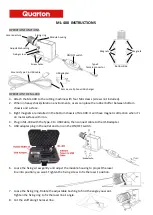
N3X
Owner’s Manual
• 47
Troubleshooting
* The message list (page 46) is also provided for your reference.
Problem
Possible Cause and Solution
The instrument does not turn on.
The instrument has not been plugged in properly. Securely insert the female plug
into the socket on the instrument, and the male plug into a proper AC outlet (page
14).
A click or pop is heard when the
power is turned on or off.
Electrical current is being applied to the instrument. This is normal.
The power is automatically
turned off.
This is normal and due to the Auto Power Off function. If necessary, set the
parameter of the Auto Power Off function (page 16).
Noise is heard from the speakers
or headphones.
The noise may be due to interference caused by the use of a mobile phone in
close proximity to the instrument. Turn off the mobile phone, or use it further away
from the instrument.
Noise is heard from the instru-
ment’s speakers or headphones
when using the instrument with
the application on iPhone/iPad.
When you use the instrument along with the application on your iPhone/iPad, we
recommend that you set “Airplane Mode” to “ON” on your iPhone/iPad in order to
avoid noise caused by communication.
The overall volume is low, or no
sound is heard.
• The Volume is set too low: set it to an appropriate level using the [MASTER
VOLUME] control (page 17).
• Make sure a pair of headphones is not connected to the headphones jack (page
18).
• Make sure that Local Control (page 45) is on.
Sound is still heard from the
instrument even though head-
phones are plugged in.
When the TRS is on, sound can be heard slightly even if the headphones are con-
nected. Turn the TRS off to mute all sound other than the headphones (page 25).
The pitch and/or tone of the
Piano Voices in certain ranges
do not sound right.
The Piano Voices attempt to precisely simulate actual piano sounds. However, as
a result of sampling algorithms, overtones in some ranges may sound exagger-
ated, producing a somewhat different pitch or tone. This is normal, and no cause
for concern.
Sound is not heard on a particu-
lar key.
Keyboard may not function normally if the key was pressed when the power was
turned on. Turn off the power and turn it again to reset the function. Do not touch
any keys when turning the power on (page 15).
Sound input to the [AUX IN] jacks
is interrupted.
The output volume of the external device connected to this instrument is too low,
resulting in the sound being cut off via the Noise Gate after it is input to this instru-
ment.
• Increase the output volume of the external device. The volume level reproduced
via this instrument’s speakers can be adjusted by using the [MASTER VOLUME]
control.
• Set the Noise Gate to off (page 41).
The damper pedal has no effect.
The pedal cord may not be properly connected. Make sure to securely insert the
pedal cord into the pedal jack (page 51).
The USB flash drive has hung up
(stopped).
• Disconnect the USB flash drive and connect it to the instrument again.
• The USB flash drive is not compatible with the instrument. Only use the USB
flash drive whose compatibility has been confirmed by Yamaha (page 36).
Mechanical noise is heard during
performance.
The keyboard mechanism of this instrument simulates the keyboard mechanism
of an actual piano. Mechanical noise is also heard on a piano.














































